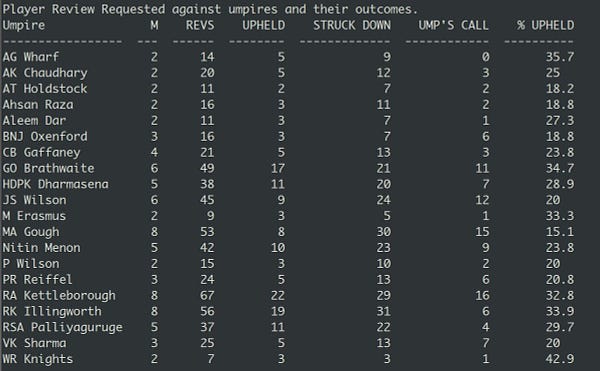Light meter is the darkest phrase in cricket. If you aren't watching the game and hear it, the words affects you physically. You see shadows instantly, monsters, saviours. Something is happening, just as nothing is about to.
Nitin Menon's light meter was either a bastion of hope or an instrument of doom. There is something so godawfully weird about cricket. It's this great sport that requires skills, athleticism, gardening, endurance and strategy. But here were are looking at middle-aged men in sun hats trying to work out a piece of technology as they hold it around groin height. Deciding our fate. How many millions of people were watching Nitin Menon and Virender Sharma's devices? These 1980s looking cellphone things just telling us if we can laugh, cry or cheer.
And this entire last session was full of mad moments, partly because of this pitch. It wasn't good, it wasn't bad, it was shifty. A ball from Ajaz Patel ragged and kept low on day one, and yet on day five, the balls were still playing low, but true. Or at least, trueish, like a story from a grandparent with a bit of harmless tax on it. Mostly the ragging went away, or stayed in non-dangerous areas. When it was low it was often slow. And the sudden rush of wickets never came.
The ball looked like it was going to be predictable. The new one helped the bowlers - for spin or pace - and then at the 30 over mark it was like someone would deflate it, and we had to wait for a replacement or reverse for the bowlers to be back in front again.


But after four days of that pattern, this old ball played some incredible tricks, and the new ball was relatively benign in comparison.


On almost every day (like an old man with a fastidious morning routine) umpires Menon and Sharma would take a light meter near stumps, and sometime in the next eight minutes we'd be off the field. Not today, today; Menon held the light metre on more occasions than Ishant Sharma touched the ball.
The pitch was on its own trip, the ball changed profiles and the light was in control of our emotions.
And look back through everything I've mentioned so far, we haven't got to the cricket yet. One ball before tea New Zealand was on cruise control on this slow and low wicket that didn't spin so much. But was tough to bat on, but also tough to be dismissed on. And New Zealand had Ross Taylor and Kane Williamson at the crease.
They have over 33,000 runs at international level. Numbers one and two all-time for New Zealand. Taylor was on his way to being the greatest Kiwi batter before Kane Williamson came in to ruin it. You absolutely would want these two at the crease if you are a New Zealander. This is your dream team, and then Taylor missed a ball from Jadeja, and he seemed to just walk.
Maybe it wasn't a traditional walk, perhaps he saw the umpire's hand rising, but there was no discussion with Williamson about the line of the ball. Taylor displayed utter New Zealand pragmatism; he knew he was out, so he left.
And that opened up the game.
Six wickets from one session is a big deal. It's all well and good if you have a shallow batting lineup - which New Zealand doesn't - or if the pitch is a minefield - which it wasn't.
After tea, Henry Nicholls reviewed an LBW with the kind of confidence I wish I could fake. He brashly walked down the wicket, completely convinced that he'd get his plummer than a plum jam dismissal overturned.
Instead, it was another wicket to Axar Patel, who India very much treated like the fifth bowler, despite the fact that he and Kyle Jamieson are statistically two of the greatest bowlers of all time (if you gerrymander the minimum wickets required).
Nicholls wicket was a problem, but there was still Williamson at the crease. A man so popular in cricket people are starting to follow him like he's a nice version of Cristiano Ronaldo.
This is Mr Steady the Ship. A man so revered that kiwi fans wear silly hats in honour of him.
A man with such a revered technique that some batters have tried to convert to it as their religion. And he had been playing forward defensive shots with his bat an improbable inch below the surface to ensure one couldn't get under it.
And yet it did. I don't know what it's like watching Kane Williamson dismissed trying to block out a draw in the final session of a Test in India as a New Zealand fan. But I assume it's like seeing your mate kiss your first girlfriend. Now imagine being one of the next batters. When the ball gets under the thickest bat in New Zealand history, how do you even go on?
But that isn't what happened, instead Tom Blundell in his first Asian Test and Rachin Ravindra in his first Test, played really well. And for a long time, it seemed like the pitch was dead, and they might edge home. Until Blundell middled a ball onto his leg stump.
That in itself is so weird. R Ashwin tried everything this match to get wickets. Sometimes bowling ten different deliveries in an over. Or at least it seemed that way. Yet he ended up with his two most important wickets from the middle of the bat, and a huge batting error from Tom Latham.
The Blundell wicket brought in Jamieson, New Zealand's third top scorer in the first innings. So far neither of Jamieson's averages make sense, it's like we're all living in his dream waiting for him to wake up. But yet this perfect specimen of humanity seemed to walk for his LBW. The TV scorers gave him caught, but he missed a straight one, was taken on the back leg, and off he went. He spent more time looking at the replay as he walked than he did thinking about a review.
Not so much Tim Southee, who at least seemed to review for the single purpose that it would take time out of the game. It certainly appeared like a tactical review, to suck out India's last few minutes of natural light. Until he saw the replay that he hadn't hit the ball, and just trudged off.
New Zealand's lack of skulduggery was incredible. No twelfth man was jogging on every over break with the scores from Pakistan's chase; the new batters didn't suddenly remember they brought out two of the same glove. The Kiwis didn't even get together mid over to pretend to talk about essential cricket matters. They just played cricket.
And if there was truly a time waisting review, it probably has to go to India, when they went with one for an Ashwin LBW. It was also probably on the wrong side of leg stump, but worth a go, in desperate times. But India didn't burn a review, they burnt a few moments of sunlight.
The Indians kept one eye on the screen and one on the sky. It felt like it was India's last moment in the game. But the light fluctuated like it was trolling everyone watching. It was light enough to play, but too dark for pace. So poor India was limited to only the most potent three-man spin creature in the game. By the end, Rahane had given up bowling two of the three in tandem, he just pressed shuffle on his iPod and let it decide his fate.
Ashwin, Jadeja, Axar, Ashwin, Axar and Jadeja bowled the last six overs in that order. Well, not so much order, but necessary chaos.
Up against this slow-bowling killing machine was two of the most unlikely enemies. Mumbai born Ajaz Patel. And the man so linked to Indian cricketers his parents doubled down on it in his name, Rachin (Rahul+Sachin) Ravindra. Just on his own Ravindra is such a weird cricketer, an opening bat who bowls part-time, being asked to bat at number seven and bowl important overs against India. Together you had someone who qualifies to play with India and another guy trying to upset half of the portmanteau of his name.
Imagine playing your first Test, and you're out in the middle trying to stop the man you are named after from getting his first win as coach.
And that was in no way the weirdest thing about the end of this game. It wasn't even Ajaz Patel who was running between wickets to get himself back on strike like he had no idea the gravity of the situation.
It was definitely the light. Had Jamieson still been in the middle, he might have blocked out the sun enough to come off the field. Hell, had a flock of birds gone over as Sharma and Menon were checking their chunky appliance, it might have been game over.
Menon was like the guy at the party who has selfies of him with a celebrity. He was showing the screen to everyone so that they knew he wasn't just bullshitting.
No one seemed to believe him, all the eyes watching this were suddenly experts. The way we all know the rules of Judo or kayaking when watching the Olympics. But we had entered a realm where it was too dark not to mention, and not light enough to play in any comfort. I swear I saw Menon give out someone and strain to see his finger in the gloom.
It was getting lighter, then darker, then seemingly both at the same time. Light wasn't electromagnetic radiation with properties from both waves and particles. It was what Nitin Menon and his universal remote said it was. Dark, light, both, neither. All at once.
And in the middle of this, the Rahul/Sachin hybrid and the kid from Mumbai blocked out three just deadset incredible spin bowlers. The number eleven and the guy who was dismissed with half a blade in the first innings. Ball after ball, off the middle of bats, some spooky moments, but hardly a chance. Ashwin was trying everything except bowling on both sides of the wicket at once, which he did do earlier this Test.
All this was happening without us knowing when it would end. One wicket, minimum overs, quick spinners, and one stray cloud from stumps. And we just had to wait; there was no answers, no certainty. Maybe New Zealand would draw, India could win, or the sun could implode leaving us all to freeze and die.
But finally the light came for the match. The pitch was shifty, the ball often soft, but the light meter and its wise men had the final say.
If there was still enough rays of sunshine left at the ground, the light meter would have read, 0-0.







